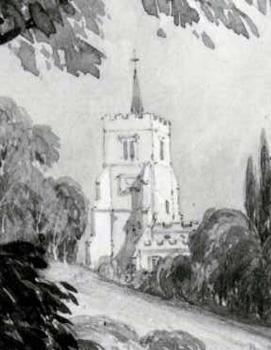Early Education in Aspley Guise

Aspley church in 1820
Volume 81 published by Bedfordshire Historical Records Society (2002) is a series of episcopal visitations edited by former County Archivist Patricia Bell. At each visitation a list of questions was sent out in advance, one of which enquired about the provision of schools in each parish. The various replies were as follows:
- 1706: "There is no lecture, School, Almsehouse or Hospital enddow'd within this parish";
- 1709: "No public or Charity schole";
- 1717: "No Charity School";
- 1720: "No Charity School"
The lack of provision for the education of poor children in the parish indicates that the Classical Academy, which was certainly in existence at this date, was for the upper strata of society from its inception.
In 1818 a Select Committee was established to enquire into educational provision for the poor. This was no doubt prompted, in part, by the recent foundation of two societies promoting education and specifically the building of schools. The Society for Promoting the Lancasterian System for the Education of the Poor was established in 1808 promoting schools run along the lines pioneered by Joseph Lancaster, who had himself copied those of Dr.Andrew Bell, in which older children taught their younger fellows. The Society was renamed the British and Foreign School Society in 1814,. It was supported by a number of prominent nonconformists, Lancaster himself was a Quaker, and sought to teach a non-sectarian curriculum. In answer to this perceived nonconformist takeover of local education the National Society was formed in 1811 to encourage the teaching of poor children along Anglican lines, including the catechism. The Select Committee sent a questionnaire to all parishes in the country asking for: particulars relating to endowments for the education of children; other educational institutions; observations of parish needs etc. At this date in Aspley Guise there was a Sunday school which was supported by voluntary contributions and taught 60 boys and 30 girls. The rector, Thomas Farmer, wrote that "the poor are desirous of having the means of education". It is worth noting that this Sunday School was just that, School provided on a Sunday and would have taught reading and writing and, perhaps, other subjects, in addition to the religious knowledge for which Sunday Schools are reserved today.
In the country generally the number of schools built continued to grow over the next fifteen years so that by 1833 the government agreed to supplement the work of the two societies, and local benefactors, by making £20,000 per annum available in grants to help build schools. It also prompted another questionnaire to be sent to each parish in England asking for details of local educational provision. The return for Aspley Guise noted that a daily school had commenced in that year containing 15 to 20 children of both sexes. The church Sunday School continued, now having 30 or 40 children and had been joined (nearly eclipsed might be more accurate) by a similar Sunday School for Wesleyan Methodists containing 90 to 100 children.